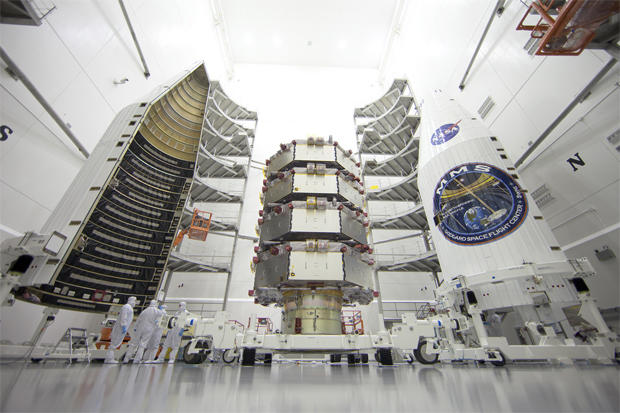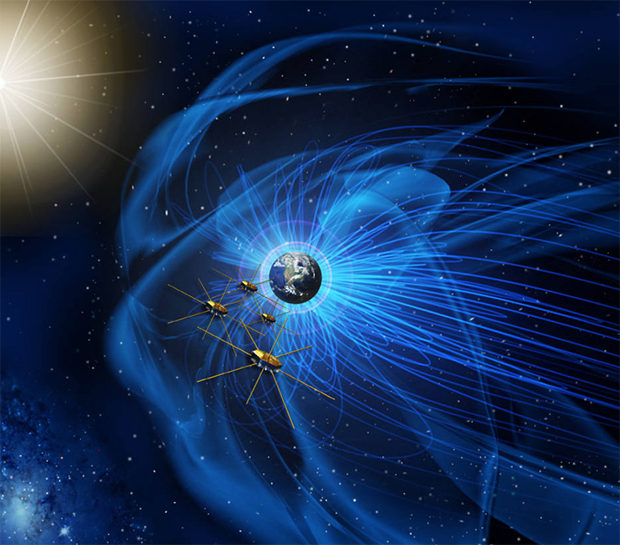NASA launches satellites to probe magnetic mystery
Kicking off a $1.1 billion mission, a United Launch Alliance Atlas 5 rocket streaked into space Thursday, boosting four NASA satellites into orbit to study interactions between Earth's magnetic field and the sun's, which generate the titanic energy discharges that drive auroras and play havoc with satellite navigation, communications and power grids.
The hard-to-study mechanism underlying space weather is known as magnetic reconnection, and it is the focus of NASA's Magnetospheric Multiscale -- MMS -- mission, a long-awaited project to reveal the underlying physics powering Earth's space environment.
Carrying the four MMS satellites stacked one atop the other in a protective nose cone fairing, the Atlas 5 roared to life and climbed away from pad 41 at the Cape Canaveral Air Force Station at 10:44 p.m. EDT (GMT-4). Thirteen minutes later, after the first of two Centaur second stage engine firings, the rocket and its satellite payload were safely in orbit.
After a second Centaur engine firing, the satellites, built at NASA's Goddard Space Flight Center in Greenbelt, Md., were released at five-minute intervals starting about one hour and 32 minutes after liftoff.
"The spin rates, the attitude, it was essentially a flawless delivery of our four satellites," said Craig Tooley, NASA MMS project manager at Goddard. "They're all healthy and turned on."
Each 3,000-pound, 12-foot-wide satellite features a suite of sensitive instruments and eight extendable antenna-like booms: four 197-foot-long radial wire booms and two 41-foot axial extensions for electric field sensors and two 16-foot booms carrying magnetometers.
When fully deployed, each satellite's booms will sweep out an area the size of a baseball field as the spacecraft slowly rotate. All four satellites will be arranged in a pyramid formation, flying within about 6 miles of each other at their closest.
The goal is to capture three-dimensional views of subtle magnetic interactions that occur very rapidly over very small regions of space.
The payoff will be a better understanding of how the sun's magnetic field and solar winds interact with Earth's magnetic field, how similar processes play out around black holes and across entire galaxies and possibly shed light on how magnetic fields can be used to help sustain nuclear fusion reactions for power generation on Earth.
The key is a phenomenon known as magnetic reconnection, the sudden annihilation of interacting magnetic fields that explosively heat and accelerate charged particles to extreme velocities.
"Magnetic fields exist throughout the universe and energy is often released by magnetic reconnection," said Jim Burch, MMS principal investigator at the Southwest Research Institute. "In the sun's super-heated corona, magnetic fields create spectacular loops. The energy stored in these structures can release, creating explosive solar flares and coronal mass ejections.
"Intense fluxes of energetic particles and giant clouds of ionized gas and magnetic fields are ejected from the sun and travel throughout the solar system. When these clouds impact other magnetic fields such as the Earth's, similar reconnection events occur and these cause intense magnetic activity and the auroral lights."
At the same time, he said, magnetic reconnection accelerates electrically charged particles "creating a hazard to space travelers and spacecraft, even disrupting ground-based power grids."
While scientists know magnetic reconnection occurs, they do not yet understand how or why. But they believe the answer will be found in the so-called "diffusion region" where events rapidly occur over very short scales.
"Adjacent magnetic fields pointing in opposite directions tend to annihilate each other, releasing their magnetic energy and heating the charged particles in the surrounding environment," Burch said. "In this process, magnetic reconnection, the magnetic fields are torn apart and reattached to their neighbors.
"The mysterious part is what goes on inside the box labeled 'diffusion region?' With MMS, we'll be able to probe the diffusion region for the first time with measurements down to the smallest scale of the plasma, the electron scale, to solve this mystery."
Paul Cassak, an associate professor at West Virginia University, described previous efforts to probe magnetic reconnection as similar to watching a football game for one minute and then waiting an hour before watching another minute.
"It would be really hard to figure out what's going on in the football game," he said. "These are the problems that have been plaguing researchers studying magnetic reconnection, we can't see the smaller scales and we can't process the data fast enough to really understand what happens right at the place where magnetic reconnection happens. This makes it difficult to see, for example, how particles get accelerated and heated during magnetic reconnection events."
The MMS satellites represent a scientific assault on magnetic reconnection.
Each satellite, with its booms extended, covers a volume measuring 94 feet thick and 369 feet across. Each solar-powered spacecraft is equipped with 11 instruments made up of more than two-dozen sensors. Sensitive Global Positioning System navigation gear and thrusters will be used to maintain relative position and orientation.
The satellites will fly in two highly elliptical orbits that first will carry them through the magnetic reconnection zone on the Earth's day side, where the solar wind, CMEs and flare debris crash into the protective bubble of Earth's magnetic field.
The MMS spacecraft then will raise the high point of their orbit to study reconnection on the back side of the planet where Earth's magnetic field tapers away in the solar wind.
That is where it's particularly interesting, Burch said, "where you have reconnection in the tail of the magnetosphere. This is what produces the aurora and the currents that carry the energy of magnetic storms."
Burch said a better understanding of magnetic reconnection also could provide insights into long-standing problems that have prevented engineers from sustaining nuclear fusion reactions using magnetic containment.
"People for 20 years or more have been trying to harness nuclear fusion by trapping particles in a doughnut-shaped magnetic field and heating these up to something like 100 million degrees when fusion starts happening," Burch said. "If you could maintain that, we will have solved the energy crisis. Trouble is, it always crashes, these temperatures always come down (because of) magnetic reconnection."
"There are practical applications once you understand how magnetic reconnection works," he said.


